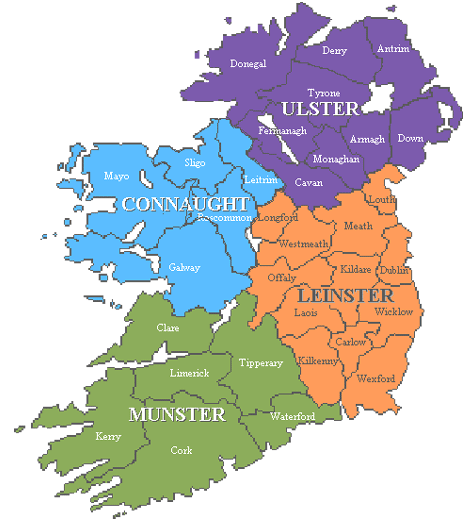
-A map of the UK (image from annamap.com).
For those who do not know much about the UK, you have England, Scotland, and Wales on one island and Northern Ireland on another. The Republic of Ireland is not part of the UK. The entire Irish island is divided into four provinces. The one farthest to the north is Ulster. Ulster is divided into nine counties. Six of these counties are part of Northern Ireland and three are part of the Republic of Ireland.

-The four provinces of the Irish island (image from becoming eireannach).
While Ireland is predominately Catholic and Northern Ireland is Protestant by a slight majority, Ulster is 51% Catholic and 43% Protestant. Anyone who knows anything about Irish history knows that religious affiliation is of central importance to life past and present.
The Irish island split into two countries as a result of the partition in 1922, where Northern Ireland chose to remain part of the UK and the Republic of Ireland was formed as an independent nation. It was stated in the Good Friday Agreement in 1998 and on other occasions that Northern Ireland can become independent at any point where its people vote in a majority to do so.
The Ulster Scots came to Ulster from Scotland centuries ago when King James offered them land in Ireland because he was tired of dealing with them on the battlefield. These people became he Scots Irish. Unfortunately, life did not get much better for them in Ulster. This led a large number of them to decide to uproot again and come to America. Due to their independent nature, many Scots Irish settled on the early frontiers once in America, much of which were in the Appalachian mountains. A large number of Appalachians today can trace their roots back to the Scots Irish.
I am currently taking a class on Irish history, which I knew very little about coming in and am still making sense of, so if I am wrong about any of this please forgive me and correct me in the comments section.
References: Contemporary Ireland (2011) by Eoin O'Malley